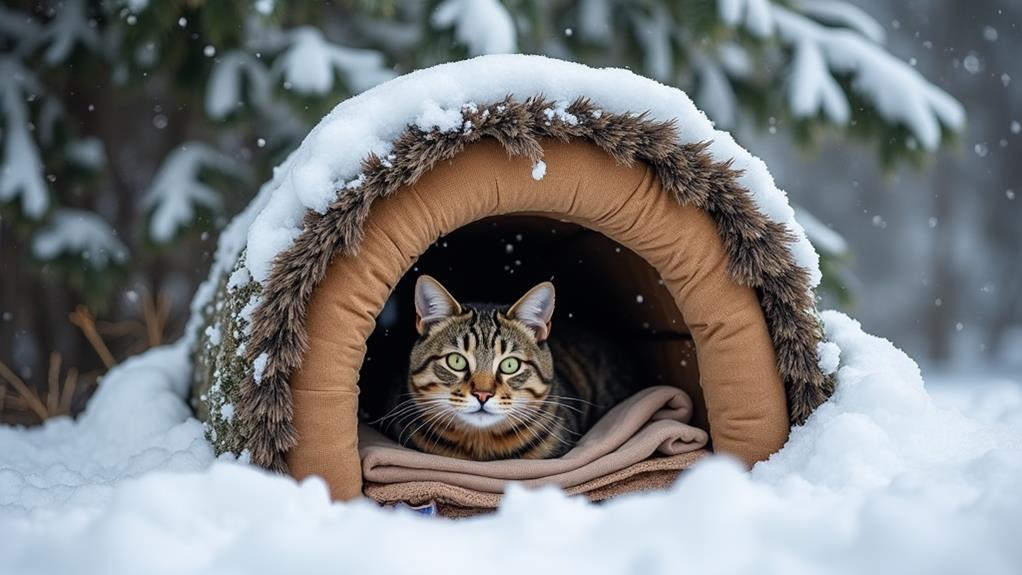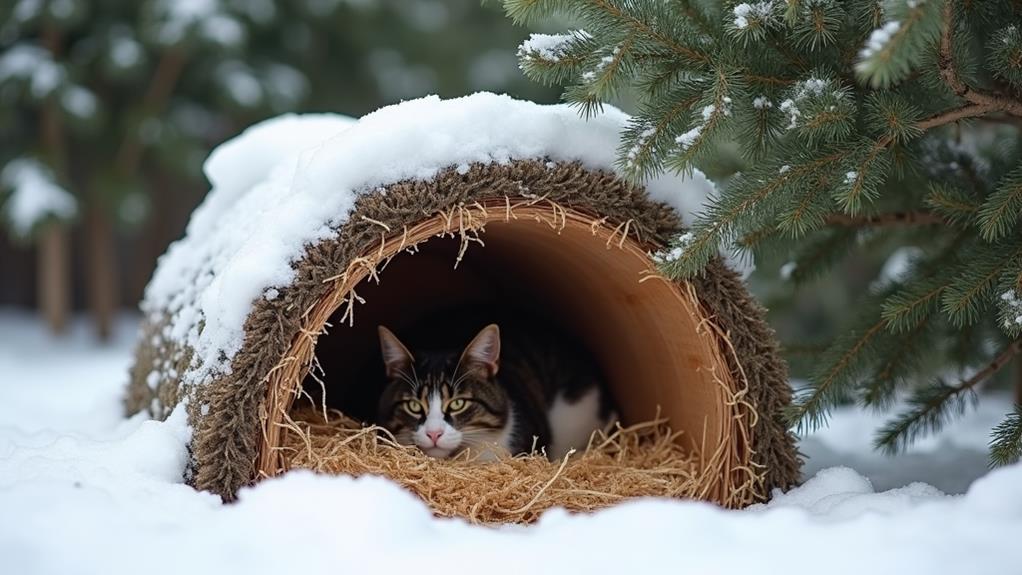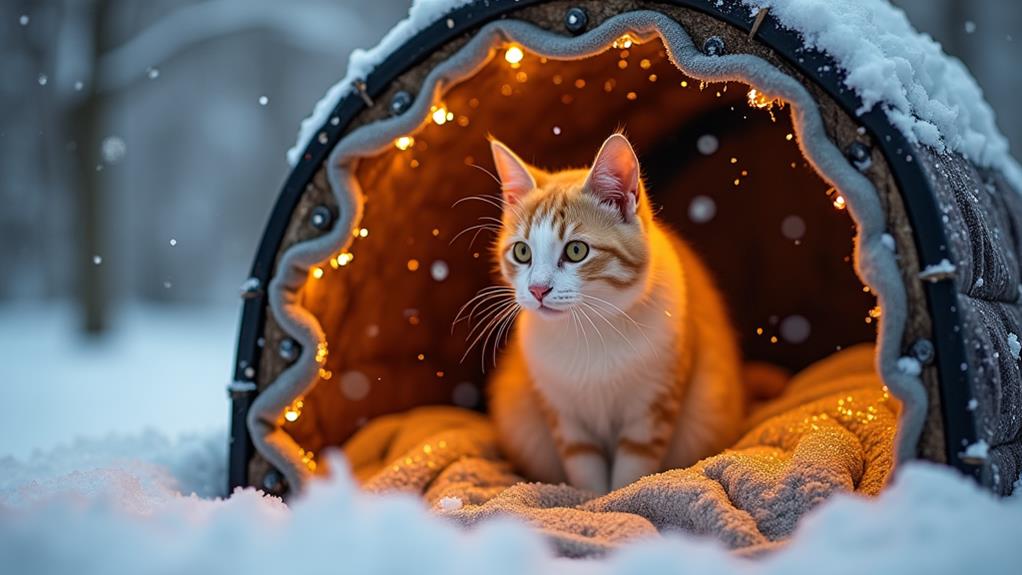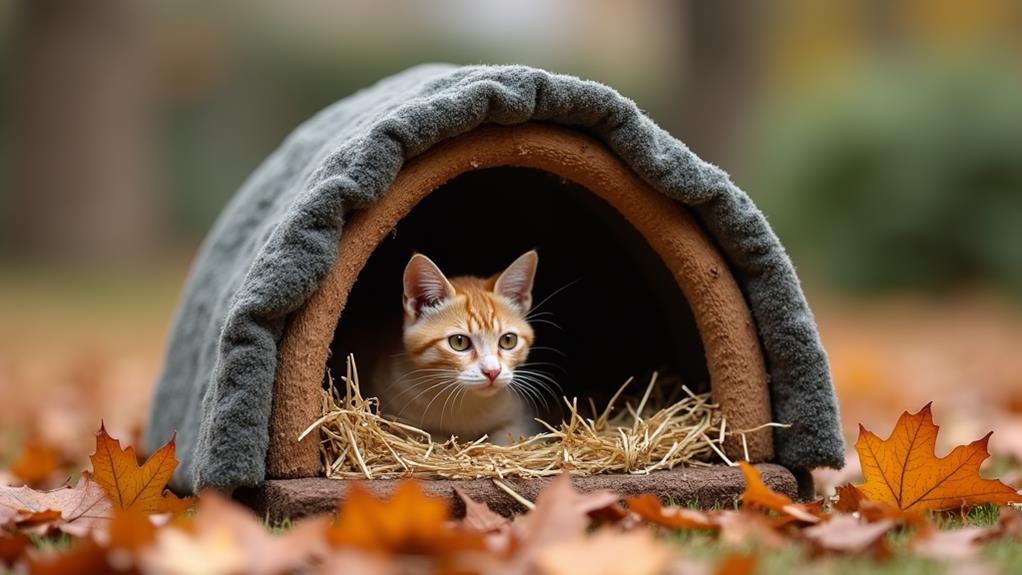What to Put in a Feral Cat Shelter: Essentials for Keeping Cats Warm

To create a warm feral cat shelter, use dry straw as insulation since it effectively retains heat and avoids moisture issues that hay can cause. Build the shelter from durable materials like a rubbermaid tote, guaranteeing it has a small entryway with a flap to block drafts. Mylar blankets are excellent for severe cold, as they reflect and trap body heat. Raise the shelter off the ground to keep it dry and prevent flooding. Inspect regularly to confirm materials remain functional and replace as needed for continued warmth. There's more to uncover about ideal shelter placement and maintenance techniques.
Essential Shelter Materials
When building a feral cat shelter, choosing the right materials is vital for providing a safe and warm environment. Start by using dry straw as your primary insulation material. Unlike blankets, straw retains heat effectively and doesn't hold moisture, which could harm a cat's health. It's important to avoid hay, as it can mold easily, leading to respiratory issues. If straw isn't available, consider using shredded newspaper. While not as effective as straw, shredded newspaper still offers some warmth and can absorb moisture to a degree.
Make certain your shelter includes small entryways with flaps. These help keep cold drafts out and offer protection from predators, making the interior more secure and warm for the cats. Regular inspections are a must to maintain shelters; check that insulation materials like straw or newspaper remain dry and free from debris or snow. This guarantees a consistently warm environment, preventing any exposure to harsh weather conditions. By focusing on these key materials and maintaining them properly, you'll create a welcoming haven that supports the well-being of your local feral cats throughout the cold season.
Effective Insulation Solutions
To effectively insulate a feral cat shelter, utilize straw as your primary material. Straw is ideal because it's dry, loose, and non-moldy, which means it traps body heat efficiently, keeping outdoor cats warm during cold months. It's crucial to avoid hay since it retains moisture and can lead to health issues. If straw is unavailable, shredded newspaper can be a decent alternative for insulation.
Consider using insulated storage bins filled with Styrofoam and straw for a DIY solution that guarantees warmth. This setup creates a cozy environment while still being accessible and cost-effective. Mylar blankets are another great addition to your shelter. By cutting and gluing these reflective blankets inside the shelter, you improve warmth by reflecting and trapping the cats' body heat, making them perfect for severe winter conditions.
Don't forget to raise your shelters off the ground. Elevated shelters help prevent dampness and potential flooding, which can compromise the effectiveness of your insulation materials. By keeping the shelters elevated, you confirm that the straw and other insulating materials remain dry and functional, providing a safe and warm haven for feral cats.
DIY Shelter Construction

Building a DIY feral cat shelter is a rewarding project that provides a safe haven for outdoor cats. Start by using a rubbermaid tote as your main structure—it's durable and easy to work with. Inside, line it with a Styrofoam cooler to provide crucial insulation, which helps trap the cats' body heat and keep the shelter warm even in the cold. Here's a quick overview of the steps:
- Entrance: Cut a six-inch diameter hole low on the tote for easy access and to prevent snow buildup.
- Insulation: Fill the cooler with straw. Unlike blankets, straw is an excellent insulator that won't absorb moisture, keeping the cats dry and warm.
- Securing the Shelter: Use duct tape to secure the cooler lid and the tote lid, guaranteeing the structure is waterproof and can withstand harsh weather.
Regularly inspect and maintain your shelter to keep it clean and accessible. Clear any snow or debris from the entrance to make certain cats can easily come and go. This simple yet effective construction can make a big difference in a feral cat's comfort and safety during the colder months.
Choosing the Right Location
Finding the perfect spot for your feral cat shelter is crucial to guaranteeing the cats' safety and comfort. Start by placing shelters in areas where the cats frequently visit, preferably close to their feeding spots. This minimizes the distance they need to travel for warmth and food. When choosing the location, avoid open spaces that expose the shelters to harsh weather and predators. Instead, use natural cover like bushes or trees to provide extra protection.
Elevate your shelters off the ground to prevent flooding and dampness, which also contributes to the shelter's warmth. Verify the placement is stable and secure, especially during heavy rain or snow. Camouflaging the shelters with paint or natural materials will help them blend into the surroundings, reducing the risk of disturbance from humans or other animals.
When considering entrance designs, keep in mind that a single door can maintain warmth, but providing two entrances offers an escape route from predators. You'll need to carefully plan these to minimize drafts. By focusing on strategic placement and protection, you'll create a safe haven where feral cats can find refuge from the elements and potential threats.
Preventing Moisture and Dampness

Moisture is a common enemy in the context of creating a comfortable feral cat shelter. Keeping these shelters dry is vital for the health and warmth of feral cats. Initially, make sure to raise the shelter off the ground. This step helps prevent water accumulation during rainy or snowy weather, ensuring that the interior stays dry. Sealing all seams and entrances is another significant measure. By doing so, you keep water from seeping in and creating a damp environment. Opt for waterproof materials when constructing the shelter to further protect against the elements.
Regular maintenance is key to preventing moisture buildup. Inspect the shelter frequently, especially after adverse weather conditions, to clear away any snow or debris that might trap moisture. This routine will help keep the shelter dry and accessible for the cats.
Here are some noteworthy tips for keeping moisture at bay:
- Raise shelters: Keep them off the ground to prevent water accumulation.
- Seal openings: Use waterproof materials and seal seams to block water entry.
- Regular inspections: Clear debris and check for moisture after rain or snow.
Insulating With Straw
In regard to insulating feral cat shelters, straw is your best bet. Unlike blankets, straw excels at retaining body heat without absorbing moisture, which can chill cats and lead to health problems. When setting up a feral cat shelter, make sure you use dry, loose, and non-moldy straw. Hay, on the other hand, should be avoided due to its tendency to retain moisture, which isn't ideal for keeping warm.
To create an effective insulation layer, fill the interior space of the shelter with straw. The goal is to provide a cozy environment that traps the cat's body heat, making it comfortable even in colder weather. If straw isn't available, you can use shredded newspaper as an alternative insulation method. It's not as effective as straw, but it still helps in trapping body heat.
Remember to regularly check and replenish the straw in the shelters. Over time, straw can become damp or compacted, losing its insulating properties. Keeping the straw dry and fluffy guarantees that it remains effective at insulating against the cold. By using straw, you'll give feral cats a warm and safe haven during chilly conditions.
Mylar for Extreme Cold

For those looking to improve feral cat shelters during extreme cold, Mylar blankets are a game-changer. They can be cut and glued inside the shelter to trap and reflect the cats' body heat, boosting warmth considerably. This reflective property of Mylar creates a warmer microenvironment by retaining the heat generated by the cats themselves. It's an effective way to counteract the cold air that can seep into the shelter.
Mylar is not only efficient but also practical. It's lightweight, waterproof, and easy to clean, making it an ideal choice for insulating shelters. These blankets are often found in winter survival kits, so they're both accessible and affordable. When using Mylar, verify it's securely attached to the interior of the shelter. This prevents any sharp edges from posing a risk to the cats.
Here's what you can do with Mylar:
- Cut and glue Mylar inside: Boost the shelter's warmth by reflecting body heat.
- Waterproof and lightweight: Ideal for easy installation and maintenance.
- Affordable insulation option: Common in survival kits, providing cost-effective solutions.
With Mylar, you can create a cozy and safe refuge for feral cats during harsh winter months.
Adding Flap Doors
Often overlooked, adding flap doors to feral cat shelters can make a significant difference in retaining warmth and blocking out cold drafts or snow. Flap doors act as a barrier, helping maintain the cozy environment inside the shelter. To guarantee they're effective, choose waterproof materials for the flap doors. This prevents them from absorbing moisture during rainy or snowy conditions, which could otherwise compromise their functionality.
When attaching flap doors, consider using VELCRO or strong glue. These methods provide easy access for the cats while making sure the doors stay securely in place. A snug fit is vital for insulation; you don't want gaps that could let cold air seep in. The tighter the fit, the better the shelter will retain warmth, keeping the cats comfortable even in harsh weather.
Regular maintenance is important for keeping flap doors in top condition. Check them after storms or heavy winds, as these conditions can cause wear and tear. Make necessary repairs promptly to guarantee the doors continue to function effectively. By focusing on quality materials and frequent upkeep, you'll provide a warm, inviting space for feral cats throughout the colder months.
Ensuring Safety and Stability

While flap doors are essential for warmth, guaranteeing the general safety and stability of feral cat shelters is just as significant. You'll want to raise these shelters off the ground to prevent flooding and dampness during rain or snow. This not only creates a stable environment but also keeps cats dry. Using sturdy materials like wood composite or insulated storage bins will help the shelters withstand harsh weather and potential predators.
It's vital to regularly inspect your shelters. Check for any structural damage or blockages from snow or debris to make sure they remain functional and safe. This maintenance assures that the cats have a reliable refuge in even the toughest conditions.
For added safety, camouflage shelters with paint or natural materials so they blend into their surroundings. This will help protect the cats from predators and make the shelters less noticeable to passersby.
- Raise the shelters: Keeps them dry and stable.
- Use sturdy materials: Wood composite or insulated bins withstand weather and predators.
- Camouflage shelters: Blends them into the environment for added safety.
Community Support for Cats
Through community support, providing winter shelters for feral cats becomes a collective effort that truly makes a difference. Organizations like Neighborhood Cats lead the charge by offering low or no-cost shelters to colony caretakers, helping keep cats warm during harsh weather. Your role in this initiative is vital, regardless of hands-on participation or simply spreading the word.
Engaging local volunteers is a powerful way to improve the welfare of these outdoor cats. By organizing shelter-building initiatives, you can contribute directly to creating safe havens for feral cats. Encourage your community to donate materials or funds for these projects, ensuring shelters are well-built and sustainable.
Educational events are another avenue to raise awareness about the significance of caring for community cats in winter. By attending or organizing such events, you can learn and share valuable information that can drive collective action and protection efforts.
Collaborating with local shelters and TNR programs builds a supportive network, effectively managing and improving the lives of feral cat populations. Your involvement can foster a more compassionate community, working together to provide the necessities needed to keep feral cats warm and safe throughout winter.




